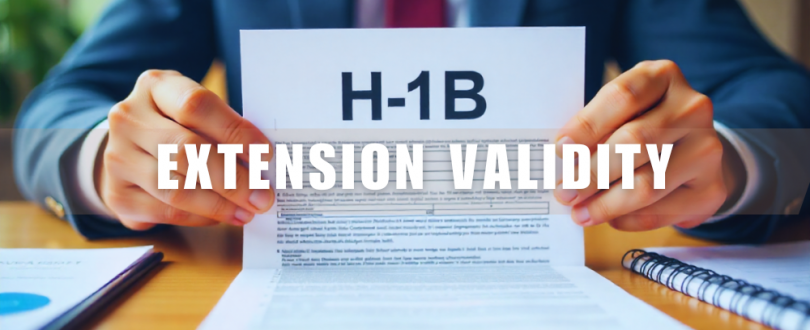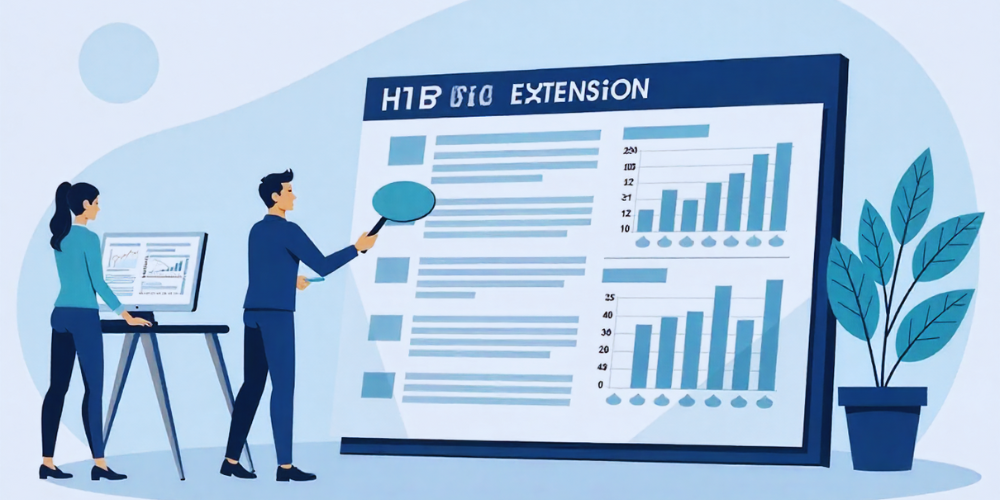
Three years — that’s how long the clock ticks for most H-1B visa holders before the renewal countdown begins. For many skilled professionals, those years go by in a blur of project deadlines, promotions, and planning what comes next. And before you know it, it’s time to file for an extension — a process that can determine not just your ability to stay employed, but your future in the U.S. altogether.
The H-1B visa isn’t just a work authorization; it’s a bridge — linking global talent with American innovation. Yet, understanding how long you can remain on that bridge requires more than just marking calendar dates. The rules around extensions can be technical, the timelines strict, and the exceptions… surprisingly flexible.
In this guide, we’ll unpack how long an H-1B visa extension is valid for, when and how you can extend beyond the standard six-year limit, and what you should know about timely filing, automatic work authorization, and special green card-related exceptions. Whether you’re an employer planning ahead or a visa holder watching the clock, this breakdown will help you stay one step ahead of expiry.
The Basics: Understanding H-1B Visa Duration
Let’s start with the foundation — how long an H-1B visa actually lasts.
Initial validity: When first approved, an H-1B visa is typically valid for up to three years. This period is granted based on the employment contract and the petition filed by the sponsoring employer.
Extension validity: Once that initial term is nearing its end, employers can request an extension — also valid for up to three additional years. That brings the standard total to six years in H-1B status.
The U.S. Citizenship and Immigration Services (USCIS) and numerous university immigration offices reaffirm this six-year framework. For instance, the University of Kansas Medical Center explains that H-1B employees can be approved for an initial three-year period, followed by extensions “not to exceed a total of six years” in H-1B status. Similarly, the University of North Carolina’s International Student and Scholar Services (ISSS) outlines that an H-1B worker’s stay “is limited to six years total, with extensions typically granted in increments of up to three years”.
In other words, under normal circumstances, the H-1B visa follows a 3 + 3 rule: an initial approval period and an equally long extension window — both carefully regulated but offering a fair amount of predictability for employees and employers alike.

Going Beyond Six Years: The Special Exceptions
For most professionals, the H-1B journey is a six-year arc — three years, plus another three. But for those pursuing permanent residency, the law provides a critical safety valve: extensions beyond the six-year limit.
When It’s Possible
There are two key pathways that allow H-1B holders to go beyond the usual cap:
1. A Pending I-140 Petition Filed 365 Days Ago or More:
If your employer has filed an employment-based green card petition (Form I-140) and it’s been pending for at least a year, you can request extensions in one-year increments beyond your sixth year.
2. An Approved I-140 with No Available Visa Number:
For those whose I-140 has already been approved — but who are unable to adjust status due to visa number retrogression or unavailability — extensions are also permitted, again typically in one-year increments until your priority date becomes current.
These exceptions, rooted in the American Competitiveness in the Twenty-First Century Act (AC21), were designed to ensure that talent doesn’t fall through the cracks of bureaucratic backlog. In simple terms: if you’ve done everything right — your green card paperwork is in the system, and you’re waiting on the government — you can keep working legally in the U.S. while you wait.
According to Clemson University’s International Services Office, H-1B employees “may extend beyond six years if a permanent residence petition has been filed at least 365 days before the end of the sixth year, or if the I-140 is approved but the priority date is not yet current.”.
Likewise, Envoy Global notes that these beyond-six-year extensions are “commonly granted in one-year increments” under AC21, offering a vital continuity of status for high-skilled professionals navigating the green card queue.
In essence, while the six-year limit may appear fixed, immigration law allows room for movement — a recognition that the system must accommodate both global talent and the realities of visa backlogs.
The Filing Timeline: Staying Ahead of Expiry
If there’s one golden rule in immigration, it’s this: never wait until the last minute.
When to File
Employers can file an H-1B extension up to six months before the current visa expires. That window is not just a courtesy — it’s a strategic buffer. Filing early helps avoid employment gaps, travel restrictions, or last-minute panic when USCIS processing times fluctuate.
The 240-Day Rule
Even if your current H-1B period expires while your extension petition is pending, you’re not left in limbo. Under the 240-day rule, you can continue working for the same employer for up to 240 days after your status expiration — as long as the extension was filed on time.
The University of North Carolina’s ISSS confirms this protection, explaining that “H-1B employees may continue employment for up to 240 days beyond the expiration of their current status while an extension is pending with USCIS”.
Practical Takeaways
For employers, this means building a compliance calendar and coordinating early with HR or legal counsel — especially if multiple H-1B employees’ visas expire around the same period. For employees, it means maintaining close communication with your sponsor, keeping copies of your I-797 receipts, and being mindful of travel plans while the extension is in progress.
In a system where timing is everything, foresight is your best protection — and sometimes, the difference between a seamless extension and a stressful scramble.

How to File for an H-1B Extension
Filing for an H-1B extension isn’t so much about reinventing the wheel as it is about precision and timing. Every document, every date matters. Here’s the process in simple terms:
Step 1: Employer Files Form I-129
The process begins with your employer, who must file Form I-129, Petition for a Nonimmigrant Worker, with the U.S. Citizenship and Immigration Services (USCIS). This form is the backbone of your extension — confirming that you’re still employed in a qualifying specialty occupation and that the terms of employment remain valid.
Step 2: Include Updated Documentation
Alongside the petition, your employer must submit:
– An updated Labor Condition Application (LCA) approved by the U.S. Department of Labor.
– Proof of ongoing employment, such as recent pay stubs or an employment verification letter.
– Any supporting documents that reflect your continued eligibility for the role.
Step 3: Receive USCIS Receipt – Work Authorization Continues
Once USCIS receives the petition, it issues a Form I-797 receipt notice. This document is more than just a confirmation — it activates your 240-day work authorization continuation, meaning you can keep working legally while the extension is under review, provided it was filed before your current H-1B expired.
Step 4: Consider Premium Processing
For those who can’t afford to wait, premium processing offers a fast-track option. For an additional fee, USCIS guarantees a 15-calendar-day turnaround — a lifesaver for employees with upcoming travel or employers needing quick confirmation.
According to Envoy Global, this expedited option is widely used for extensions, helping minimize downtime and reduce uncertainty during the waiting period.
In essence, the extension process is a test of coordination: employer paperwork, legal precision, and strategic timing — all working in sync to keep your status uninterrupted.
Common Mistakes and Misconceptions
When it comes to H-1B extensions, misinformation spreads faster than updates from USCIS. Let’s set the record straight on a few common myths that could derail even the most careful applicant.
“You can’t extend beyond six years.”
False. While the standard limit is six years, H-1B holders with a pending or approved I-140 may be eligible for one-year extensions beyond this limit. This safeguard, authorized under the AC21 Act, helps bridge the gap between temporary status and permanent residency.
“Extensions are automatic.”
Definitely not. Each extension requires a new petition filed by your employer before your current H-1B expires. Late filings can leave you out of status — even if your job continues. There’s no auto-renewal button in the immigration world.
“You can’t work while waiting for approval.”
Wrong again. If your extension was filed on time, the 240-day rule protects your right to continue working legally while the petition is pending. It’s one of the most employee-friendly provisions in the system, designed to prevent unnecessary job disruptions.
According to Boundless Immigration, these extension pathways and protections exist precisely to “avoid penalizing foreign workers caught in long processing delays”. Similarly, MyAttorneyUSA emphasizes that “H-1B status may be extended beyond the six-year statutory limit if the individual is the beneficiary of a qualifying green card filing,” clearing up one of the most persistent myths in the H-1B ecosystem.
In short, the system is strict but fair — if you file correctly and on time, you don’t lose your footing. The real risk lies in misunderstanding the rules, not in the process itself.
Quick Reference Table
When it comes to H-1B extensions, details can blur fast — so here’s a crisp summary to keep things straight:
| Scenario | Extension Validity | Notes |
|---|---|---|
| Initial H-1B period | Up to 3 years | Standard approval period |
| Standard extension | Additional 3 years | Brings total stay to 6 years |
| Pending I-140 (365+ days) | 1-year increments | Eligible for extensions beyond 6 years |
| Approved I-140 (no visa number) | 1-year increments | Until visa number becomes available |
| Timely filed extension | 240-day work continuation | Legal work authorization while awaiting USCIS decision |
This table reflects guidance from USCIS, university immigration offices, and legal advisories like Envoy Global and Boundless — offering a quick at-a-glance reference for HR professionals and foreign employees alike.
FAQ
1. How long can I stay in the U.S. on an H-1B visa?
The standard maximum stay for H-1B visa holders is six years — made up of an initial three-year period and a possible three-year extension. However, certain applicants with pending or approved green card petitions (Form I-140) may qualify for one-year extensions beyond six years until a visa number becomes available.
2. Can I extend my H-1B visa after six years?
Yes, under specific conditions. If your I-140 has been pending for more than 365 days or approved but delayed due to visa retrogression, you may extend your H-1B in one-year increments beyond the six-year cap under the AC21 Act.
3. How early should I apply for an H-1B extension?
USCIS allows employers to file an extension up to six months before the current H-1B expires. Filing early is highly recommended to avoid gaps in status or work authorization, especially given processing delays.
4. What happens if my H-1B expires while my extension is pending?
If your employer files the extension before your current H-1B expires, you can continue working for up to 240 days beyond the expiration date while the petition is being processed. This is known as the 240-day rule — a crucial protection for timely filers.
5. Can I change employers while my H-1B extension is being processed?
Yes. The H-1B portability rule allows you to change employers as long as your new employer files a valid H-1B transfer petition (Form I-129). You can start your new job as soon as USCIS issues a receipt notice for that petition — no need to wait for full approval.
Conclusion: Keeping Your H-1B Journey on Track
The H-1B visa was designed to attract global expertise — but keeping that expertise in motion means knowing the rules of the road. In short:
– Your initial period lasts up to 3 years.
– You can extend for another 3 years, bringing your total to 6 years.
– If you have a pending or approved I-140, you may qualify for one-year extensions beyond six under AC21.
– And as long as you file on time, the 240-day rule protects your ability to keep working while waiting for USCIS approval.
Navigating these details can be complex, especially when green card timelines or visa number retrogressions come into play. That’s why consulting with an immigration attorney or your employer’s HR/legal department is not just smart — it’s essential.
Ultimately, the H-1B extension isn’t just a renewal of paperwork — it’s a bridge. One that facilitates the transition of skilled professionals from temporary work status to long-term residency, stability, and contribution to the U.S. economy.
So, file early, stay informed, and treat each extension as one more confident step toward permanence.

